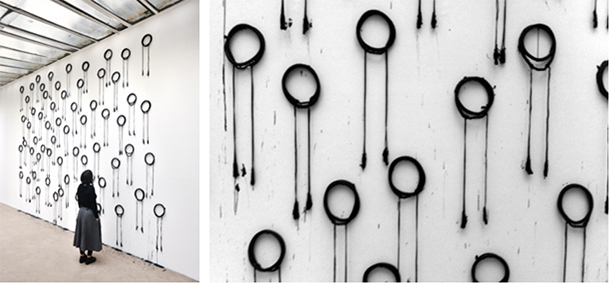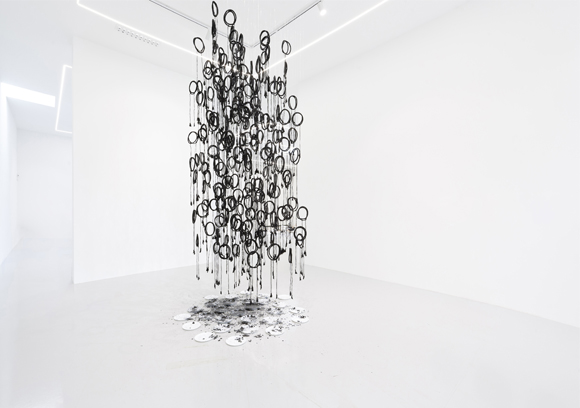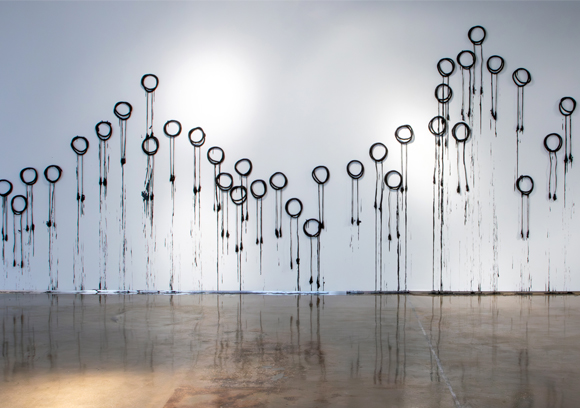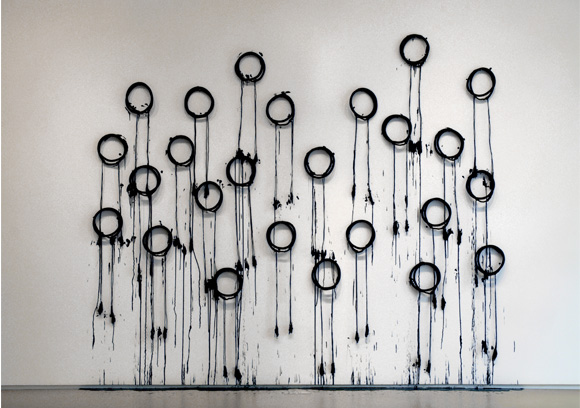| |
|
|
42.
| Oil, Oil, Oil, Oil |
| |


2012, 250 x 300 cm, 100 agals.
Exhibition view of Oil, Oil, Oil, Oil, Yvon Lambert, 2013, Paris.
Courtesy of the artist and Jane Lombard, New York.
Ed. of 5 + 1 A.P.
''This menacing, disturbing resonance is how mounir fatmi tackles the complex question of insufficient energy resources, unfortunately frequently
caused by political powers motivated solely by profits, instead of necessary global and social responsibility.''
Silvia Cirelli, Art curator, September 2023

Oil, Oil, Oil, Oil suspended
Exhibition view from How much is Enough, Ceysson & Bénétière, 2022, Saint-Etienne.
Courtesy of the artist.

Oil, Oil, Oil, Oil Analytics
Exhibition view from Whispered Stories of Forgotten Wires, Piero Atchugarry Gallery, 2023, Miami.
Courtesy of the artist and Piero Atchugarry Gallery, Miami.

Oil, Oil, Oil, Oil
Exhibition view of Oil, Oil, Oil, Oil, Yvon Lambert, 2013, Paris.
Courtesy of the artist.
|
|
|
|
|
| Collection of FDAC L'Essonne, Chateau de Chamarande
Oil, Oil, Oil, Oil installe le spectateur dans un face à face avec une œuvre qui met à l'épreuve sa patience et sa résistance en le confrontant à la vision obsédante d'une composition répétant un unique motif. L'installation, présentée à la galerie Jane Lombard à New York en 2012 et à la galerie Yvon Lambert en 2014, est réalisée au moyen d'agals, accessoires du vêtement traditionnel arabe fait de corde, qu'on attache autour du keffieh pour le maintenir en place. Les agals ont été trempés dans de la peinture noire avant d'être fixés sur le mur blanc de l'espace d'exposition où ils laissent de longues traînées de liquide noir allant jusqu'au sol. L'agal vient rejoindre la liste des objets détournés de Mounir Fatmi tels que les câbles d’antenne, la cassette VHS, la barrière hippique ou encore les balais.
Par son titre, l'œuvre désigne clairement l'objet de son propos, à savoir la question des ressources énergétiques. Son œuvre s'attache à reproduire un mécanisme, une machinerie. Oil, Oil, Oil, Oil expose les rouages et le fonctionnement d'un appareil d'extraction et de production et montre de quelle manière une technique conditionne toute une économie et les modes de vies qui l'accompagnent. Plus largement, Mounir Fatmi interroge avec Oil, Oil, Oil, Oil les moyens de l'art et de l'artiste pour traiter des grands bouleversements politiques et sociaux, environnementaux et économiques.
Mounir Fatmi prend ainsi avec Oil, Oil, Oil, Oil le parti d'une stricte économie de moyens. Inspirée du minimalisme, l'utilisation des cercles noirs (motifs récurrents dans la géométrie plastique de Mounir Fatmi) sur fond blanc en rappelle la technique de répétition et la rigueur formelle A cette différence près cependant : si à strictement parler il ne s'agit de rien d'autre que d'agals peints en noirs, il est très difficile, voire impossible pour le spectateur de ne pas se livrer au jeu des associations d'idées. De simples cercles noirs dégoulinants se transforment en tâches de Rorsach. Et leur interprétation ne relève, après tout, que de la responsabilité du spectateur... Liberté est donnée au spectateur d'imaginer que ces boucles noires sont comme autant de zéros qu'on retrouve dans la comptabilité de l'industrie pétrolière générant des milliards de chiffre d'affaire, ou encore qu'elles sont comme des bouches avides d'où coulent le sombre liquide et qui semblent contre toute raison en réclamer d'avantage : "Oil, Oil, Oil, Oil !".
Mounir Fatmi, qui se déclare lui-même "post-minimalist" produit ici un minimalisme "chaud", réincarné, où les motifs géométriques sont à la fois des signes neutres et des signes potentiellement chargés de significations multiples. En parvenant à dire le plus en disant le moins, il réalise avec Oil, Oil, Oil, Oil une forme de litote artistique qui fait gagner considérablement en force une œuvre s'inscrivant au sein d'une démarche artistique cohérente et engagée.
Studio fatmi, Février 2017.
|
|
Oil, Oil, Oil, Oil places the viewer face to face with a piece that tests one’s patience and resistance, confronting him or her with the obsessive vision of a composition repeating a single motif. The installation, presented in the Jane Lombard gallery in New York in 2012 and in the Yvon Lambert gallery in 2014, is composed of agals, a traditional Arab clothing accessory made of rope, attached around the keffieh to hold it in place. The agals were dipped in black paint before being attached to the white wall in the exhibition space, where they leave long trails of black liquid streaming down to the ground. The agal joins Mounir Fatmi’s list of repurposed objects that includes antenna cables, VHS cassette tapes, horse racing barriers, and even brooms.
With its title, the work clearly indicates the subject of its purpose: the question of energy resources. His work endeavors to reproduce a mechanism, or a type of machinery. Oil, Oil, Oil, Oil exposes the inner workings of an extraction and production apparatus and shows a technique that determines an entire economy and the ways of life that accompany it. In a broader sense, with Oil, Oil, Oil, Oil, Mounir Fatmi questions the means of art and artists to handle major political, social, environmental, and economic disruptions.
With Oil, Oil, Oil, Oil, Mounir Fatmi economizes on materials. Inspired by minimalism, the use of black circles (commonly recurring motifs in Mounir Fatmi’s geometric art), on a white background brings the technique of repetition to mind, and yet the rigidity of shapes presents this difference: If strictly speaking it is nothing but agals painted black, it is very hard if not impossible for the spectator to avoid engaging in the association of ideas. Simple, rolling black circles transform into Rorschach tests, and after all, their interpretation is the viewer’s responsibility… The viewer is given the liberty to imagine that these black curls are reminiscent of the many zeros that are found in the oil industry’s bookkeeping as it generates billions, or perhaps they can be seen as greedy mouths from which dark liquid flows as they seem against all reason seem to cry out for more, “Oil, Oil, Oil, Oil!”
Mounir Fatmi, who states that he is a “post-minimalist,” creates “hot,” reincarnated minimalism, in which the geometric motifs are both neutral and laden with multiple possible significations. In succeeding to say the least by expressing the least, with Oil, Oil, Oil, Oil, he creates a form of an understatement that dramatically enhances a work that is part of a coherent and committed artistic approach.
Studio fatmi, February 2017.
Traduit du français par Christina Washington.
|
|
|
|